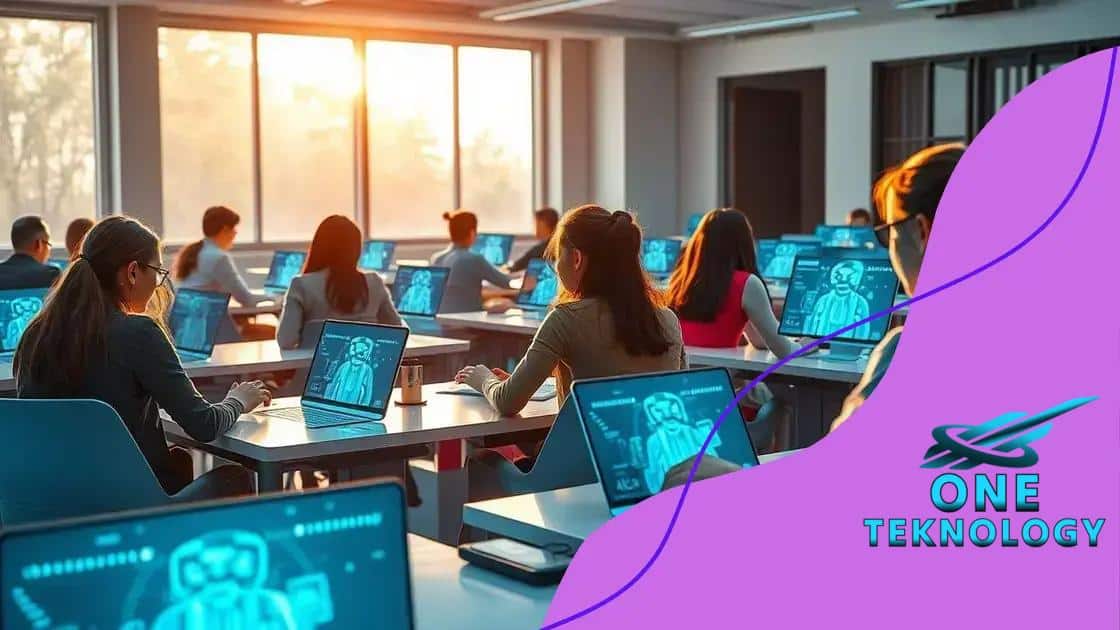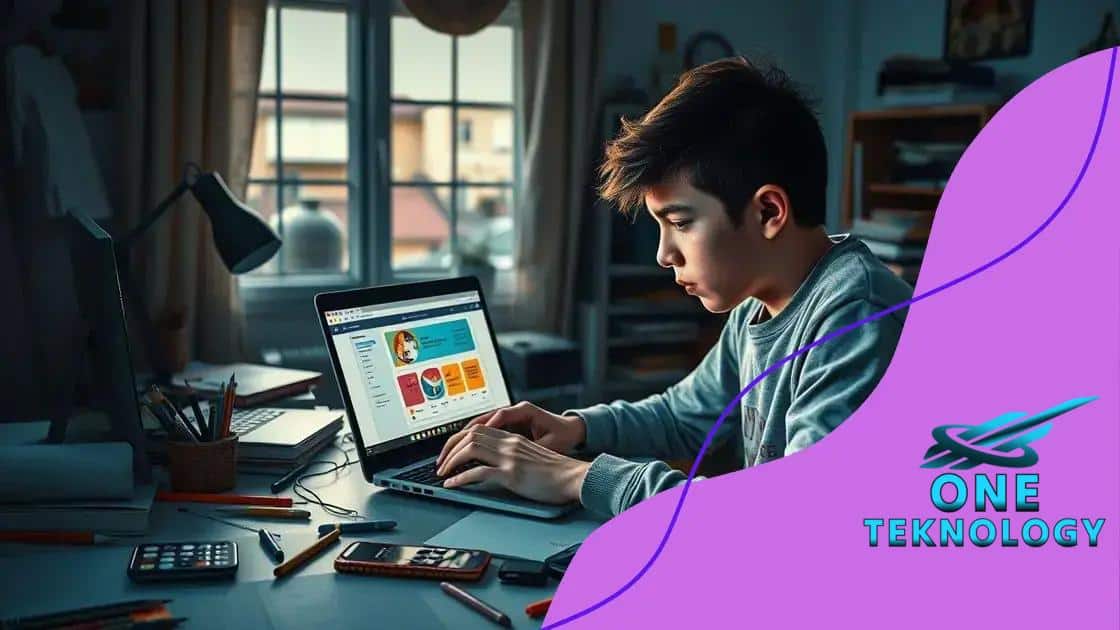The future of learning: Virtual classrooms and AI tutors

The future of learning involves integrating technology like AI tutors and virtual classrooms, enhancing personalized education, and providing immersive experiences to better meet diverse student needs.
The future of learning: Virtual classrooms and AI tutors is changing how we think about education. Have you ever wondered how these tools could shape your learning experience? Let’s dive in.
Understanding virtual classrooms
Understanding virtual classrooms is essential in today’s educational landscape. These innovative spaces enable students to learn from anywhere, breaking down geographical barriers. Moreover, they provide a flexible and inclusive learning environment.
What is a Virtual Classroom?
A virtual classroom is an online platform that simulates a traditional classroom. It allows students and teachers to interact in real-time using video conferencing, chat boxes, and shared resources. This setup encourages participation and collaboration.
Key Features of Virtual Classrooms
- Real-time interaction through audio and video capabilities.
- Access to diverse learning materials, including videos and interactive tools.
- Flexibility in scheduling, catering to different time zones.
- Inclusive settings that accommodate various learning styles and needs.
In a virtual classroom, educators can use various tools to enhance the experience. Features like breakout rooms foster group discussions, while polls engage students and obtain immediate feedback. This technology offers opportunities for personalized learning paths, allowing students to progress at their own pace.
Moreover, these classrooms help in developing essential skills such as digital literacy and self-discipline. As students navigate online resources and projects, they learn to manage their time effectively and communicate clearly in a digital context.
Benefits of Virtual Classrooms
The benefits of virtual classrooms are substantial. They eliminate the need for physical presence, making education accessible to a larger audience. Students from different regions can collaborate and exchange ideas, enriching the learning experience.
- Increased access to education for remote learners.
- Cost-effectiveness, reducing travel and textbook expenses.
- Ability to revisit recorded sessions for better understanding.
- Enhanced engagement through interactive tools.
As we embrace technology, understanding the dynamics of virtual classrooms is more important than ever. They represent a shift toward a more adaptable and learner-centered approach to education.
Benefits of AI tutors in education
The benefits of AI tutors in education are transforming how students learn. These intelligent systems offer personalized support, making it easier for learners to grasp complex subjects. Instead of a one-size-fits-all approach, AI tutors tailor their teaching methods based on individual needs.
Personalized Learning Experience
AI tutors analyze a student’s performance and adjust their teaching accordingly. This personalized approach helps students focus on areas where they struggle. With continuous feedback, learners can progress at their own pace, creating a more effective learning environment.
Immediate Support
Another advantage is that AI tutors provide instant assistance. Students can ask questions and receive explanations without waiting for a human teacher. This feature encourages curiosity and exploration, as students feel more empowered to seek answers.
- Immediate feedback on assignments and quizzes.
- 24/7 availability, allowing for learning anytime.
- Reduction in the learning gap by providing extra help.
AI tutors also support diverse learning styles. Whether a student learns better through visual aids, speaking, or writing, AI adjusts to fit these preferences. This adaptability enhances student engagement and motivation.
Data-Driven Insights
Users benefit from data-driven insights that help educators track progress easily. Teachers can identify which students need extra help and what concepts are challenging. This analysis informs future lessons, making them more relevant and effective.
Moreover, as AI tutors learn from interactions, they become better equipped to address student needs over time. This continuous improvement benefits both students and teachers, creating a smarter educational system.
- Analytics to measure student success.
- Insights on common problem areas in the curriculum.
- Support for teacher planning and curriculum adjustments.
The future of education is bright with the integration of AI tutors. They not only enhance learning but also redefine the roles of educators, allowing them to focus on what they do best—teaching and inspiring students.
Challenges in implementing virtual learning

Implementing virtual learning comes with its own set of challenges. While technology offers immense opportunities, adapting to new methods can be difficult for students and educators alike. Understanding these challenges is crucial for maximizing the benefits of virtual education.
Technical Issues
One primary challenge is technical issues. Not all students have access to reliable internet or devices suitable for online learning. This digital divide can create inequalities in education, impacting student performance. Also, teachers may face hurdles in managing technology and troubleshooting problems during lessons.
Engagement and Motivation
Keeping students engaged can be more challenging in a virtual environment. The lack of in-person interactions might lead to feelings of isolation. Virtual learning requires students to be self-motivated, which can be difficult without the structure of a physical classroom.
- Distractions at home can interfere with learning.
- Lack of direct interaction with peers and teachers may reduce engagement.
- Students may struggle to participate actively in online discussions.
Moreover, the reduced face-to-face interaction can lead to a decrease in class community. Students might feel disconnected from their peers, making it harder to form friendships and collaborate effectively. This can also affect their emotional well-being during the learning process.
Assessment Difficulties
Assessing student performance can also be tricky. In a typical classroom, teachers can observe students’ understanding in real-time. However, in virtual learning settings, it might be challenging to gauge how well students are absorbing the material. Traditional testing methods may not translate well to an online format.
- Cheating may become easier with online assessments.
- Inconsistent evaluation standards between online and in-person learning.
- Difficulty in providing personalized feedback for improvement.
As schools and organizations adapt to this new learning landscape, overcoming these challenges is essential. Trying out different strategies can help enhance the virtual learning experience, facilitating better outcomes for students.
The role of technology in personalized learning
The role of technology in personalized learning is becoming increasingly vital in modern education. With tools designed for individual needs, students can learn at their own pace and in their preferred ways. This approach makes learning more engaging and effective.
Adaptive Learning Platforms
Adaptive learning platforms are one of the most significant technological advances. These systems analyze students’ performance and adjust the learning experience accordingly. For instance, if a student struggles with a concept, the platform might provide additional resources or practice problems tailored to that specific need.
Interactive Learning Tools
Another essential technology includes interactive learning tools. These resources, such as educational apps and games, allow students to experience lessons in dynamic ways. By incorporating visuals and interactive elements, these tools make complex topics more understandable.
- Use of simulations to demonstrate real-world concepts.
- Gamification to motivate learners through rewards and challenges.
- Access to diverse multimedia resources for various learning styles.
Additionally, technology supports collaboration among students. Virtual classrooms enable learners to work together on projects, share insights, and provide feedback. This interaction deepens understanding and fosters a sense of community, even when students are miles apart.
Data-Driven Insights
Data analytics also play a crucial role in shaping personalized learning experiences. By tracking student progress, educators can identify trends and adjust their teaching strategies. For example, if many students struggle with a particular topic, teachers can modify their approach to help clarify concepts.
- Real-time feedback helps guide learning adjustments.
- Analysis of student habits can inform better resource allocation.
- Tailoring lessons based on student interests increases engagement.
As we incorporate more technology in personalized learning, the educational landscape continues to evolve. By utilizing these tools, educators can create a more inclusive and effective learning environment that meets the diverse needs of all students.
Future trends in education technology
The future trends in education technology promise to revolutionize the way we teach and learn. Innovations are emerging rapidly, reshaping classrooms and providing new opportunities for engagement.
Artificial Intelligence in Education
One major trend is the incorporation of artificial intelligence (AI) into learning environments. AI can offer personalized learning experiences by adapting content to meet individual student’s needs. This tailored approach helps students learn at their own pace and increases retention of information.
Virtual and Augmented Reality
Another exciting trend is the use of virtual and augmented reality (VR and AR) in education. These technologies create immersive learning experiences. For example, history students can explore ancient civilizations through VR, while science students can conduct virtual experiments in a safe environment.
- Enhances engagement through immersive experiences.
- Provides real-world applications of theoretical concepts.
- Allows for exploration without geographical limitations.
Moreover, gamification continues to gain traction in education technology. By integrating game-like elements into learning tasks, educators can make learning more enjoyable and motivating. Students are more likely to participate actively when they see learning as a game rather than a chore.
Mobile Learning Solutions
Mobile learning is another trend that cannot be overlooked. With the widespread use of smartphones and tablets, students can learn anywhere and anytime. Mobile apps offer flexibility and convenience, allowing learners to access resources on-the-go.
- Empowers learners to study at their own pace.
- Encourages lifelong learning through easy access to information.
- Facilitates collaboration through social features in apps.
As we look forward, it’s clear that technology will continue to play a critical role in shaping the educational landscape. The integration of education technology not only enriches the learning experience but also prepares students for a future where digital skills are essential.
FAQ – Frequently Asked Questions about the Future of Learning: Virtual Classrooms and AI Tutors
How do AI tutors enhance the learning experience?
AI tutors provide personalized feedback and adapt lessons to meet individual student needs, helping them learn at their own pace.
What role do virtual classrooms play in education?
Virtual classrooms allow students to attend lessons from anywhere, fostering flexibility and accessibility while maintaining real-time interaction.
What are the benefits of using VR and AR in education?
VR and AR create immersive learning experiences, enabling students to explore complex subjects in engaging and interactive ways.
How can technology help with student assessments?
Technology can provide data-driven insights, allowing educators to track progress and tailor assessments to better evaluate student understanding.






